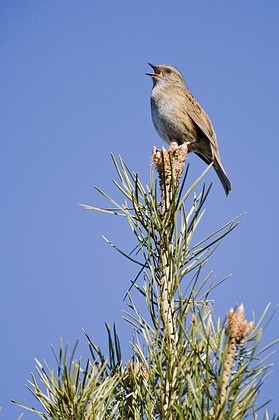Quick summary of city bird-watching day
Summary by Tarvo Valker
Photo: Arne Ader
Translation: Liis
Dunnock
Dear city bird friends!
The city birdwatching day this year is once again past and the first preliminary quick summary has been made too.
Favourable spring weather and the early spring helped to bring about both the long species count and the numerous participation. This time, observation results from 21 cities were forwarded and there were more than 110 observers. Here, a great thank you to all!
Kiviõli, Mustvee, Narva ja Sillamäe were represented for the first time in the city bird-watching.
Altogether 113 bird species were noted in the cities – more than ever before, and 33 species more than for instance in last, very late spring. In Haapsalu, where at least two watching groups have been out regularly on the last Sunday of March (this Sunday even three) – 79 bird species were registered which is equal to the best result to date (from 2008). Haapsalu also achieved the longest list of species this year although Tallinn was bested by only 2 species, and 75 species were registered also from Paldiski. Among inland cities the result from Tartu was certainly remarkable – from there too more than 70 species, more exactly, 73.
Signs of the early spring were also reflected in the abundance of many migrants – white stork (Ciconia ciconia; seen in 8 cities), wagtail (Motacilla alba; 20 cities), dunnock (5 cities) and black redstart (Phoenicurus ochruros; 5 cities). The first wheatear and penduline tits (Remiz pendulinus) were also seen (Tallinn, Tartu).
But there were also surprises in the other direction. The biggest was surely that despite active participation from many coastal cities nowhere the Northern pintail (Anas acuta) (!) was noted. Early waders were also seen only modestly – ringed plover (Charadrus hiaticula) only in Haapsalu, oystercatcher (Haematopus ostralegus) only in Kärdla, common snipe (Gallinago gallinago) only in Tartu and Tapa, and the pied avocet (Recurvirostra avosetta) for instance was missing altogether.
The ace species this time are surely also interesting:
Haapsalu: Bewick's swan (Cygnus columbianus bewickii), lesser scaup (Aythya affinis), ringed plover, bearded tit (Panurus biarmicus)
Kärdla: oystercatcher, dipper (Cinclus cinclus)
Paide: Wheatear (Oenanthe oenanthe)
Paldiski: red-throated loon (Gavia stellata), black guillemot (Cepphus grylle)
Põltsamaa: curlew (Numenius arquata)
Tallinn: collared dove (Streptopelia decaocto)
Tartu: marsh harrier (Circus aeruginosus), roughlegged buzzard (Buteo lagopus)
Tõrva: merlin (Falco columbarius)
Although there is a little less than a year to the next city birdwatching day, the Estonian Ornithological Society has other splendid birdwatching events coming quite soon.









